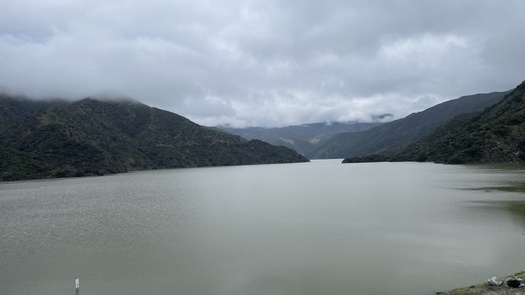
-
4.5K Views 0 Comments 0 Likes

By Caleigh Wells for KCRW.
Hours after another storm soaked Southern California, LA County’s principal stormwater engineer Sterling Klippel stands at the base of the San Gabriel Dam, looking like a kid in a candy store. He gazes in awe at the thousands of gallons of stormwater rushing through this dam every second.
“Just this October, this facility was completely drained,” he says.
This dam is almost 300 feet deep in the middle, and it went from empty to full in less than six months. And it’s just one of a dozen dams in the county.
Soggy Southern California has gotten more than two feet of rain this season –about double an average year, making it one of the top 10 wettest years.
“It's amazing to see it when it's here, and every drop is precious. So we do our best to capture every drop of it,” says Klippel.
Los Angeles County is on track to capture enough stormwater this year to quench the year-round water needs of more than a quarter of the county’s residents. It’s good news, but much work is still needed to meet local water use goals.
'An excellent job of for the infrastructure we have
“We're making strides, and we just need to make sure that we don't let our foot off the gas,” says Bruce Reznik. He leads the nonprofit LA Waterkeeper, the city’s self-proclaimed water watchdog. “We have done a good job for the infrastructure we have.”
That’s thanks to nearly century-old infrastructure that’s still working.
Trickling waterfalls in the San Gabriel Mountains typically drain into giant dams like the San Gabriel Dam, built in the 1930s. When they get full, public works officials open the floodgates at the bottom of the barriers to send the water downstream.
“From there, we release it and send it down to our spreading grounds, these large basins,” says Klippel. “The water then will percolate through this kind of sandy gravelly geology here and recharge these local aquifers where later it's pumped out for local municipal water use.”
'A century's worth of poor planning
Klippel says LA County gets about a third of its water from those aquifers while the rest is imported from Northern California or the Colorado River.
But the City of LA aims to flip that equation by 2035, using two-thirds of local water and cutting Southern California's dependence on imported water. Reznik says the local infrastructure is just not set up for that yet.
“Much of that is because … so much of LA is channelized and concretized and urbanized that we're not letting Mother Nature do its job of capturing the stormwater, letting it recharge our groundwater,” he says. “We are trying to undo a century's poor planning around water, and it will take us a while.”
LA is so developed and has such a high flood risk that the county has focused on funneling water straight to the ocean as quickly and safely as possible for decades.
In big storms like we’ve seen this winter, that’s happening no matter how hard Klippel tries to stop it. “With so much water in the system at this point, some water is still making its way to the ocean.”
Significant investments can solve infrastructure woes, but Californians decided years ago that two-thirds of voters must approve new stormwater capture taxes. That’s an extremely high bar.
“Unfortunately, it's tough to fund stormwater projects,” says Resnik. “There has been a decade's long lack of funding for stormwater infrastructure.”
This is why people like Reznik were so thrilled when county voters passed Measure W five years ago, which devotes $280 million yearly to water projects.
But as the climate crisis worsens, more money has to go toward maintaining current infrastructure. For example, wildfire burn scars result in more loose soil falling into the dams, leaving less water space.
Officials anticipate spending several billion dollars to hit that 2035 goal to use primarily local water.
“Which seems pretty ambitious to me,” says USC Assistant Professor of Civil and environmental engineering Dan McCurry. But, he says stormwater capture is one of the best tools we’ve got for reducing our reliance on imported water.
“We're not talking about complicated, energy-intensive, expensive engineering treatment processes like we have to do for wastewater reuse. So in some sense, when it's available, stormwater capture is low-hanging fruit.”
Source: Suzanne Potter/PNS
Caleigh Wells wrote this article for KCRW.

At Desert Local News, connections are everything. We're not just another social networking platform—we're a lively hub where people from all walks of life come together to share stories, spark ideas, and grow together. Here, creativity flourishes, communities grow stronger, and conversations spark global awareness.